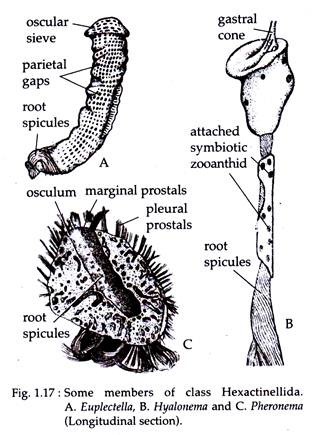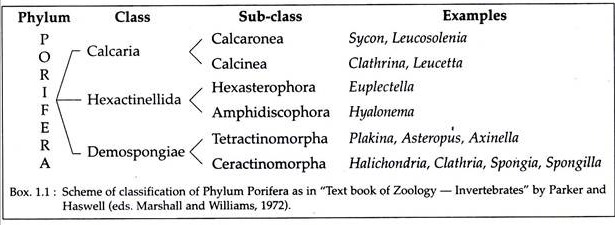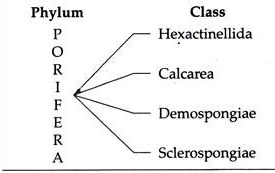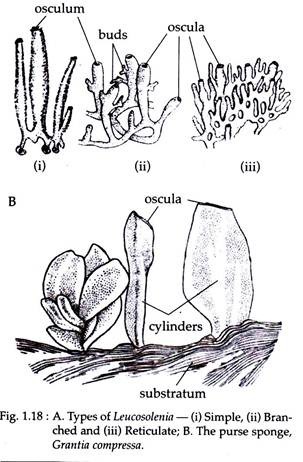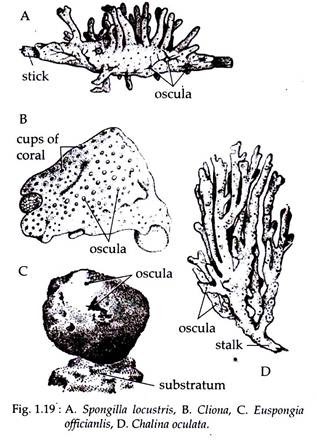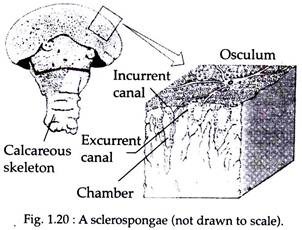In this article we will discuss about the Phylum Porifera:- 1. Classification of Phylum Porifera 2. Diagnostic Features of Phylum Porifera 3. Scheme of Classification 4. Systematic Resume.
Classification of Phylum Porifera:
Phylum Porifera, constitute of sponges that are the most primitive of the multicellular animals, lacking organs, but having well developed connective tissue. In comparison to other metazoans, the cells of sponge show a much higher degree of independence such that it resembles somewhat a protozoan colony.
The lack of any conspicuous movement of body parts of the sponges convinced Aristotle, Pliny and other ancient naturalists that sponges were plants. It was much later, in 1765, when internal water currents were first observed, that the animal nature of the sponges was established.
Sponges are found all over the world and at all depths of the ocean. However, most sponges prefer relatively shallow water, but some groups (glass sponges) prefer deeper waters. Poriferans present a great variety of external forms.
ADVERTISEMENTS:
They may be saucer-shaped, cup-shaped, tubular, rod-shaped, foliaceous, trumpet-shaped, fan-shaped, mushroom-shaped, lobed, branched, irregular etc. The forms are even variable in the same species and is therefore of little use in identification. Adult sponges are usually sessile; the motile phase is the larva produced through sexual reproduction.
Etymology:
Latin: porus, pore; ferre, to bear
Diagnostic Features of Phylum Porifera:
i. Sedentary, aquatic, sessile adults, occurring singly or in colonies.
ADVERTISEMENTS:
ii. Generally no characteristic symmetry is seen.
iii. Multicellular but with few cell types; tissue organisation very much restricted and lacking organs and co-ordination between cells.
iv. Body perforated by a number of pores.
v. They possess a canal system through which water current flows transporting food and oxygen.
ADVERTISEMENTS:
vi. Characteristic flagellated cells called choanocytes, lines the inner side of the body wall and are related with water circulation and feeding.
vii. Absence of a true body cavity or gut.
viii. Presence of an elaborate skeletal system of either calcareous or siliceous spicules or protein (collagen, sometimes called spongin) fibres or a combination of these. Sometimes, foreign particles may also be present.
ix. Exclusively filter feeder;
x. Gas exchange by diffusion.
xi. Absence of nervous tissues.
xii. Both hermaphrodite and gonochoristic forms exist. Reproduction occurs both asexually by buds and gemmules, and sexually. The ova and sperms develop from the archaeocytes.
xiii. Development indirect through a free swimming, ciliated, planktonic larvae.
Scheme of Classification of Phylum Porifera:
Sponges were studied extensively by Grant in 1836 and gave the name Porifera. The classification of sponges is based almost entirely on microscopic skeletal structures. Such divisions are not unanimous particularly in the case of horny and siliceous sponges.
ADVERTISEMENTS:
The phylum Porifera consists of 10,000 species of which 50 are fresh water ones. The classification followed in this text is based on the classificatory plan outlined by Ruppert and Barnes, 1994.
Systematic Resume:
Class Hexactinellida (Greek: hex, six; actions, rays):
i. Entirely marine, chiefly occurs in deep- water habitats, at a depth of 10-30 cm.
ii. Skeleton of 6-rayed or triaxon siliceous spicules often fused into vase-shaped structures.
iii. Pinacocytes absent, instead the epidermis forms a net-like syncytium formed from interconnecting pseudopodia of amoebocytes.
iv. Choanocytes are restricted to finger-like simple or folded chambers.
v. The spongocoel opens by a wide osculum.
Examples:
Euplectella (Fig. 1.17A), Hyalonema (Fig. 1.17B), Pheronema (Fig. 1.17C), Monoraphis.
Class Calcarea (Latin: Calcarius, limy):
i. Entirely marine, shallow coastal water species.
ii. Skeleton of separate spicules made of calcium carbonate (lime)*, either calcite or aragonite.
iii. Osculum narrow and provided with oscular fringe.
Examples:
Sycon (Scypha) (Fig. 1.21), Leucandra, Leucosolenia (Fig. 1.18A), Grantia (Fig. 1.18B).
Class Demospongiae:
(Greek: demos, people; sponges, sponge):
i. Mostly marine but a few are fresh water and is the largest class containing over 90% of the total sponge species.
ii. Skeleton composed of siliceous spicules, spongin fibers or both.
iii. Choanocytes form very small, round type of flagellated chambers.
Examples:
Spongilla (fresh water sponge) (Fig. 1.19A), Euspongia (bath sponge) (Fig. 1.19C), Cliona (boring or sulphur sponge) (Fig. 1.19B), Halichondria, Chalina (Fig. 1.19D), Hippospongia (horse sponge).
Class Sclerospongiae:
i. Marine, exhibits cryptic habits and prefer caves.
ii. Skeleton contains spicules of both silica and aragonitic calcite as well as spongin (Fig. 1.20).
iii. Spicules, Spongin fibers and the surrounding living tissues rest on a solid basal skeleton of calcium carbonate or are enclosed within calcium carbonate chambers.
Examples:
Acanthochaetetes, Astrosclera, Stromatospongia.
